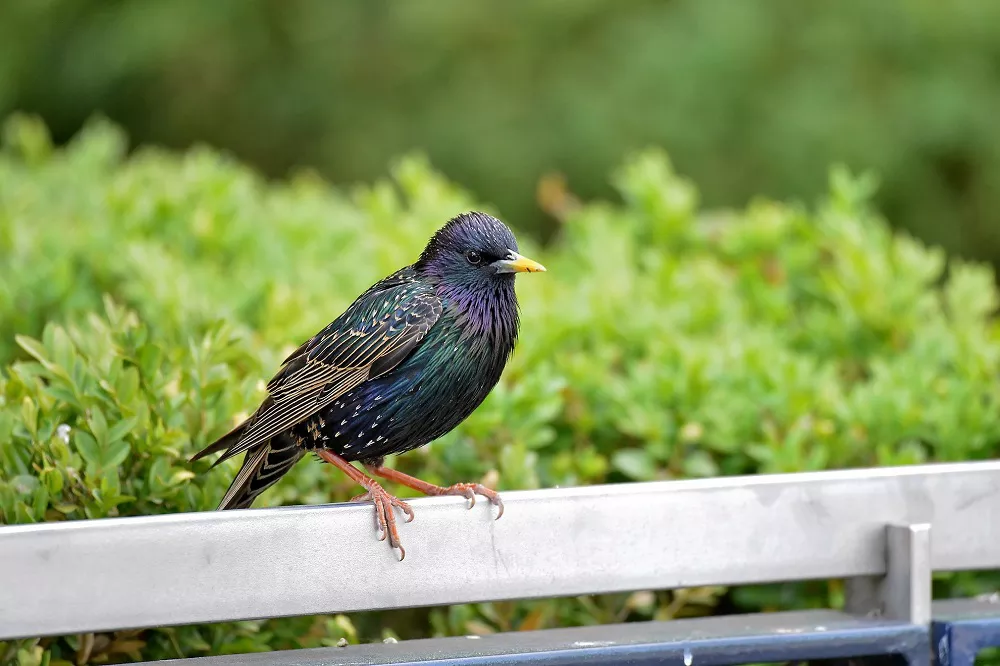The European Starling (Sturnus vulgaris) is a fascinating bird species that has captured the attention of bird enthusiasts, researchers, and casual observers alike. Known for its remarkable adaptability and impressive vocalizations, the European Starling is one of the most widespread and recognizable bird species across Europe and North America. In this article, we will delve into the physical characteristics, plumage variations, and unique attributes that define this remarkable avian species.
Physical Characteristics:
The European Starling is a medium-sized passerine bird, measuring approximately 19 to 23 centimeters (7.5 to 9 inches) in length. With a wingspan ranging from 31 to 44 centimeters (12 to 17 inches), it possesses a robust and agile physique. Its weight varies between 60 and 100 grams (2.1 to 3.5 ounces).
Plumage and Coloration:
The European Starling showcases a striking appearance, particularly during the breeding season. Adults feature glossy black feathers with iridescent purple and green hues that shimmer under sunlight. This plumage, however, is not present throughout the year. During the winter months, the plumage fades, revealing a speckled appearance with white tips on the feathers, resembling a mottled brownish-gray coloration.
Distinctive Features:
Several distinguishing features set the European Starling apart from other avian species. One notable characteristic is its pointed bill, which is yellow during the breeding season and black during winter. The bird’s strong and slender legs are typically pink or yellow. Another remarkable attribute is the short tail, which is square-shaped in flight.
In addition to its physical attributes, the European Starling possesses unique vocalizations. These birds are highly vocal and capable of mimicking a wide range of sounds, including human speech, other bird species, and even mechanical noises.
Sexual Dimorphism:
Sexual dimorphism in European Starlings is subtle, with males and females appearing similar in size and overall appearance. However, during the breeding season, male starlings exhibit brighter and more intense colors compared to females. The male’s plumage becomes especially vibrant, with richer tones of purple and green, while the female retains a slightly duller coloration.
Juvenile Plumage:
Young European Starlings exhibit distinct plumage that differs from adult birds. Juveniles typically have a brownish appearance with pale spots and streaks across their feathers. As they mature, their plumage gradually transitions into the adult pattern over the course of several months.
Behavior and Habitat
European Starlings are highly social birds that typically live in large flocks. They are adaptable birds that can thrive in a variety of habitats, including urban areas, farmland, and open woodland. In North America, they are often found in cities and suburbs, where they build their nests in cavities such as tree holes, birdhouses, and building crevices.
During breeding season, males perform elaborate courtship displays to attract females. These displays include puffing out their feathers, bowing, and singing complex songs. Once a pair has formed, the male and female work together to build a nest using twigs, grasses, and other materials. The female lays between 4-6 eggs, which both parents incubate for approximately two weeks.
After hatching, the young stay in the nest for about three weeks before fledging. During this time, the parents feed them a diet of insects, fruit, and seeds. Once the young leave the nest, they continue to be fed by their parents for an additional two weeks before becoming fully independent.
Diet and Feeding Habits
European Starlings are omnivorous birds that have a varied diet. They feed on insects such as beetles, ants, and grasshoppers, as well as fruits, seeds, and grains. In urban areas, they are known to scavenge food from garbage cans and dumpsters.
One of the unique feeding behaviors of the European Starling is its ability to feed in large flocks. During the winter months, thousands of Starlings can gather in large flocks to roost and feed. These flocks can cause damage to crops and property, leading to conflicts with humans. Despite this, the European Starling remains a beloved bird species among many birdwatchers and nature enthusiasts.
Conclusion:
The European Starling stands out as an intriguing and visually captivating bird species, renowned for its glossy black feathers, iridescent hues, and extraordinary vocal capabilities. Its adaptability, coupled with its striking appearance, has contributed to its widespread distribution across Europe and North America. Observing the European Starling in its natural habitat offers a unique opportunity to appreciate the beauty of avian diversity and the intricate intricacies of the natural world.


 Facebook
Facebook  Instagram
Instagram  Youtube
Youtube 